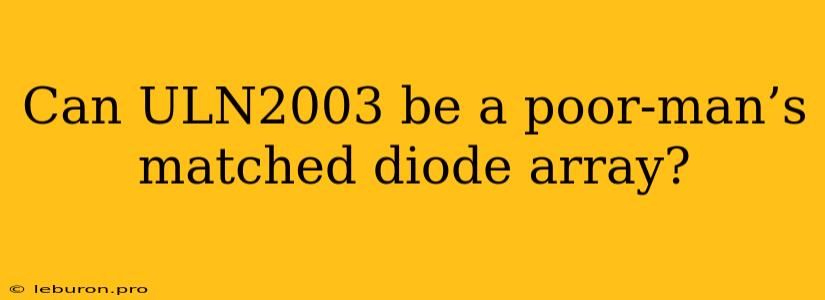The ULN2003 Darlington array driver is a versatile and widely used integrated circuit, often employed for driving inductive loads like motors and solenoids. While it's not a direct replacement for a matched diode array, it can serve as a cost-effective alternative in certain applications, particularly where the need for high-current drive is less critical. This article delves into the potential use of the ULN2003 as a "poor-man's" matched diode array and explores its capabilities and limitations.
Understanding the ULN2003 and Matched Diode Arrays
The ULN2003 is a monolithic IC that contains seven independent Darlington transistor pairs. Each pair provides a high-current drive capability, capable of sinking up to 500 mA per channel. The Darlington configuration offers high current gain, enabling the driver to control substantial loads with relatively low input currents.
On the other hand, a matched diode array consists of a group of diodes designed with closely matched forward voltage drops. These arrays are primarily used for applications where precise voltage regulation or current sharing is essential, particularly in high-power circuits.
Can ULN2003 Substitute a Matched Diode Array?
While the ULN2003 can serve as a "poor-man's" matched diode array in some scenarios, it's crucial to understand the differences and limitations. Here's a breakdown:
Similarities:
- Current Control: Both the ULN2003 and matched diode arrays can be used for current control, albeit in different ways. The ULN2003 achieves this by regulating the current flowing through the transistors, while a diode array achieves it by controlling the current distribution across the diodes.
- Multi-channel Operation: Both components offer multiple channels, allowing for simultaneous control of multiple loads.
Differences:
- Forward Voltage Drop: The forward voltage drop of a Darlington transistor is significantly higher than that of a diode. This difference can be critical in applications where voltage regulation is crucial.
- Current Matching: The ULN2003 doesn't guarantee perfect current matching across its channels. While it can be used in scenarios where precise current sharing is not a major concern, it's not ideal for applications requiring tightly controlled current distribution.
- Power Dissipation: Due to the higher forward voltage drop, the ULN2003 can dissipate more power compared to a matched diode array.
Applications Where the ULN2003 Can be Used as a "Poor-man's" Diode Array:
- Driving LEDs: The ULN2003 can be used to drive multiple LEDs simultaneously, providing a simple and cost-effective solution. However, the higher forward voltage drop might result in reduced brightness compared to using dedicated LED drivers.
- Current Limiting in Low-Power Circuits: In circuits with low power requirements and where precise current matching is not critical, the ULN2003 can be utilized for basic current limiting.
- Simple Logic Level Control: The ULN2003's high-current capability makes it suitable for controlling logic level devices like relays, solenoids, or motors with relatively low power consumption.
Conclusion
The ULN2003, with its high-current drive capability and multi-channel nature, can indeed be utilized as a "poor-man's" matched diode array in certain applications. However, it's crucial to recognize its limitations, especially in scenarios where tight current matching, precise voltage regulation, or high-power operation is required. For these demanding applications, dedicated matched diode arrays remain the superior choice.
The ULN2003 offers a cost-effective solution for driving inductive loads and managing currents in various applications. While it may not provide the same level of precision and control as a specialized matched diode array, it serves as a valuable component in various electronics projects where its capabilities align with the application requirements. By carefully considering the limitations of the ULN2003 and understanding its strengths, it can be effectively employed as a versatile and cost-effective option for driving loads and controlling currents in numerous electronics projects.
